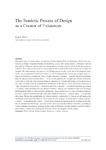Mostrar o rexistro simple do ítem
The semiotic process of design as a creator of existences
| dc.contributor.author | Ponte, Raquel | es_ES |
| dc.date.accessioned | 2014-10-02T12:31:50Z | |
| dc.date.available | 2014-10-02T12:31:50Z | |
| dc.date.issued | 2012 | es_ES |
| dc.identifier.citation | Culture of communication / Communication of culture, 2012: 1265-1273. ISBN: 978-84-9749-522-6 | es_ES |
| dc.identifier.isbn | 978-84-9749-522-6 | es_ES |
| dc.identifier.uri | http://hdl.handle.net/2183/13415 | |
| dc.description.abstract | [Abstract] This article aims to present, based on American Charles Sanders Peirce’s philosophy (1839-1914), how creation in Design integrates elements of possibility, quality and variety present in Firstness with the generality of Thirdness, with the intent of shaping objects of human material culture in the Secondness of existence. Such products that result of Design projects can be understood as the exterior side of ideas and thoughts. We understand the development of a Design project, as well as the use of the designed object by the user, as processes of unlimited semiosis, in which signs generate increasingly complex signs in a process of continuous development. Thus, thoughts stimulate existences — material objects that permeate daily life and, as a result, human culture — which, in turn, generate new thoughts and actions ad infinitum. In this article, firstly the three phenomenological categories of Peircean philosophy will be presented, as they form the basis of all the philosophical architecture of the thinker, which includes his Semiotics or Logic. The doctrine of Synechism — or the principle of the continuum — will also be described. Synechism is a concept which permeates not only Peirce’s Objective Idealism and Realism but also his Cosmology and Pragmatism. Based on this theoretical substratum, Design will be seen as a way of creating existences as well as a semiotic process, through which these material existences — concrete signs — will generate other signs. Taking into consideration the inherent semiotic characteristic of Design, we will analyze the components of the sign triad. Then we will examine how the designer, by intentionally creating existences in reality — in human material culture — brings about practical consequences for the experiential universe. We will demonstrate that Design, seen as a semiotic process, must take Esthetics and Ethics, according to Peirce’s branches of normative sciences, as their point of departure, and that designers must bear both of these notions in mind when creating new products, which will integrate material culture. | es_ES |
| dc.language.iso | eng | es_ES |
| dc.publisher | Universidade da Coruña | es_ES |
| dc.title | The semiotic process of design as a creator of existences | es_ES |
| dc.type | info:eu-repo/semantics/conferenceObject | es_ES |
| dc.rights.access | info:eu-repo/semantics/openAccess | es_ES |






